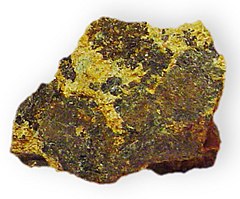Cummingtonite
| Cummingtonite | |
|---|---|
 |
|
| General | |
| Category | Inosilicate |
|
Formula (repeating unit) |
(Mg,Fe2+)2(Mg,Fe2+)5Si8O22(OH)2 |
| Strunz classification | 9.DE.05 |
| Crystal system | Monoclinic |
| Crystal class | Prismatic (2/m) H-M symbol: (2/m) |
| Space group | Monoclinic Space group: C2/m |
| Unit cell | a = 9.53 Å, b = 18.23 Å, c = 5.32 Å; β = 101.97°; Z = 2 |
| Identification | |
| Color | Dark green, brown, gray, beige; colorless to pale green in thin section |
| Crystal habit | Rarely as distinct crystals. Columnar to fibrous and granular |
| Twinning | Simple and lamellar – common |
| Cleavage | Good on {110} intersecting at 54 and 126° |
| Fracture | Splintery |
| Tenacity | Brittle |
| Mohs scale hardness | 5–6 |
| Luster | Vitreous to silky |
| Diaphaneity | Translucent, will transmit light on thin edges. |
| Specific gravity | 3.1–3.6 |
| Optical properties | Biaxial (+) |
| Refractive index | nα = 1.639–1.671 nβ = 1.647–1.689 nγ = 1.664–1.708 |
| Birefringence | δ = 0.025–0.037 |
| Pleochroism | With increasing iron content, weak; X = Y = colorless; Z = pale green |
| 2V angle | Measured: 65° to 90°, Calculated: 70° to 90° |
| Diagnostic features | Characterized by light brown color and needlelike, often radiating habit. difficult to distinguish from anthophyllite or gedrite without optical and/or X-ray tests. |
| References | |
Cummingtonite is a metamorphic amphibole with the chemical composition (Mg,Fe2+)2(Mg,Fe2+)5Si8O22(OH)2, magnesium iron silicate hydroxide.
Monoclinic cummingtonite is compositionally similar and polymorphic with orthorhombic anthophyllite, which is a much more common form of magnesium-rich amphibole, the latter being metastable.
Cummingtonite shares few compositional similarities with alkali amphiboles such as arfvedsonite, glaucophane-riebeckite. There is little solubility between these minerals due to different crystal habit and inability of substitution between alkali elements and ferro-magnesian elements within the amphibole structure.
Cummingtonite was named after the town of Cummington, Massachusetts, where it was discovered in 1824. It is also found in Sweden, South Africa, Scotland, and New Zealand.
Cummingtonite is a member of the cummingtonite-grunerite solid solution series which ranges from Mg7Si8O22(OH)2 for magnesiocummingtonite to the iron rich grunerite endmember Fe7Si8O22(OH)2. Cummingtonite is used to describe minerals of this formula with between 30 and 70 per cent Fe7Si8O22(OH)2. Thus, cummingtonite is the series intermediate.
Manganese also substitutes for (Fe,Mg) within cummingtonite amphibole, replacing B site atoms. These minerals are found in high-grade metamorphic banded iron formation and form a compositional series between Mn2Mg5Si8O22(OH)2 (tirodite) and Mn2Fe5Si8O22(OH)2 (dannemorite).
...
Wikipedia
